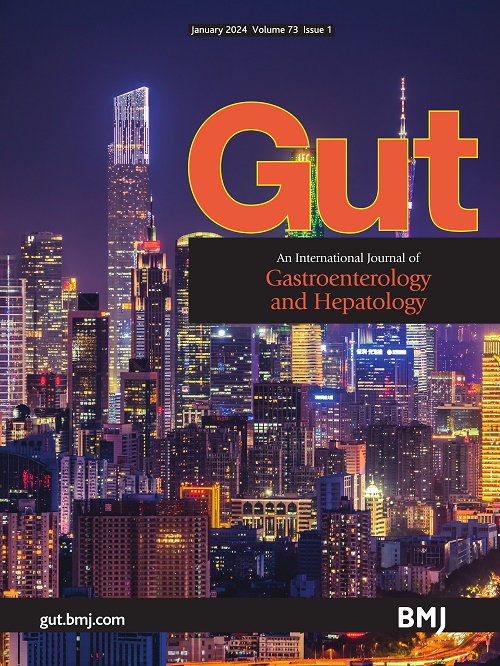Are functional dyspepsia and gastroparesis really ‘interchangeable’ diseases?
IF 25.8
1区 医学
Q1 GASTROENTEROLOGY & HEPATOLOGY
引用次数: 0
Abstract
Functional dyspepsia and gastroparesis are characterised by similar primary symptoms: nausea, vomiting, postprandial fullness, early satiety and upper abdominal discomfort. However, the population prevalence of the two conditions is very different. The global prevalence of functional dyspepsia (54 127 respondents from 26 countries) was 7.2% (range 2.2–12.3%).1 On the other hand, the standardised prevalence of gastroparesis in the UK (Clinical Practice Research Datalink database2) and in the USA (US national administrative health insurance claims database3) were, respectively, 13.8 (95% CI 12.6 to 15.1) and 267.7 (95% CI 264.8 to 270.7) cases per 100 000 persons, that is, 0.014–0.267%. This wide prevalence range may reflect different criteria for ‘gastroparesis’ in nationwide databases. Based on the Rochester Epidemiology Project (Olmsted County, Minnesota, USA), the age-adjusted prevalence of definite gastroparesis (delayed gastric emptying by standard scintigraphy and typical symptoms for>3 months) was 24.2 (95% CI 15.7 to 32.6) per 100 000.4 When including probable (typical symptoms and food retention on endoscopy or upper gastrointestinal study) and possible (typical symptoms alone or delayed gastric emptying by scintigraphy without gastrointestinal symptoms) gastroparesis, the overall prevalence was 50.5 (95% CI 38.1 to 62.8) per 100 000, or approximately 0.5%. Thus, the estimated population prevalence of functional dyspepsia is at least 15-fold higher than that of gastroparesis. Given the marked differences in management for the two conditions, it is essential to make an accurate diagnosis of gastroparesis when patients present with upper gastrointestinal symptoms. For example, gastric per-oral endoscopic myotomy (G-POEM) is an efficacious treatment for gastroparesis based on the only sham-control trial available5 with supportive evidence from meta-analyses of open-label studies, such as the weighted mean difference in total Gastroparesis Cardinal Symptom Index (GCSI) score of −1.56 (95% CI −1.89 to −1.24, p<0.001) in 20 studies involving 797 patients followed for 8.39±4.18 months. …功能性消化不良和胃轻瘫真的可以“互换”吗?
功能性消化不良和胃轻瘫的主要症状相似:恶心、呕吐、餐后饱腹感、早期饱腹感和上腹部不适。然而,这两种情况的人群患病率却大不相同。功能性消化不良的全球患病率(来自26个国家的54 127名应答者)为7.2%(范围2.2-12.3%)另一方面,英国(临床实践研究数据链数据库2)和美国(美国国家行政健康保险索赔数据库3)胃轻瘫的标准化患病率分别为每10万人13.8例(95% CI 12.6至15.1)和267.7例(95% CI 264.8至270.7),即0.014-0.267%。这种广泛的流行范围可能反映了全国数据库中“胃轻瘫”的不同标准。基于罗切斯特流行病学项目(美国明尼苏达州奥姆斯特德县),经年龄调整后的明确胃轻瘫(标准闪烁成像显示胃排空延迟,并伴有典型症状,持续时间为10 ~ 3个月)的患病率为每10万人24.2例(95% CI 15.7 ~ 32.6)。当包括可能的(内镜检查或上消化道检查显示的典型症状和食物滞留)和可能的(仅存在典型症状或闪烁成像显示胃排空延迟,但无胃肠道症状)胃轻瘫,总患病率为每10万人50.5例(95% CI 38.1 ~ 62.8)。或者说大约0.5%。因此,估计功能性消化不良的人群患病率至少是胃轻瘫的15倍。鉴于这两种疾病在治疗上的显著差异,当患者出现上胃肠道症状时,准确诊断胃轻瘫是至关重要的。例如,胃经口内窥镜下肌切开术(G-POEM)是一种有效的胃轻瘫治疗方法,这是基于开放标签研究的meta分析中唯一可用的假对照试验,例如在20项研究中,797例患者随访8.39±4.18个月,胃轻瘫主要症状指数(GCSI)总分的加权平均差异为- 1.56 (95% CI - 1.89至- 1.24,p<0.001)。...
本文章由计算机程序翻译,如有差异,请以英文原文为准。
求助全文
约1分钟内获得全文
求助全文
来源期刊

Gut
医学-胃肠肝病学
CiteScore
45.70
自引率
2.40%
发文量
284
审稿时长
1.5 months
期刊介绍:
Gut is a renowned international journal specializing in gastroenterology and hepatology, known for its high-quality clinical research covering the alimentary tract, liver, biliary tree, and pancreas. It offers authoritative and current coverage across all aspects of gastroenterology and hepatology, featuring articles on emerging disease mechanisms and innovative diagnostic and therapeutic approaches authored by leading experts.
As the flagship journal of BMJ's gastroenterology portfolio, Gut is accompanied by two companion journals: Frontline Gastroenterology, focusing on education and practice-oriented papers, and BMJ Open Gastroenterology for open access original research.
 求助内容:
求助内容: 应助结果提醒方式:
应助结果提醒方式:


